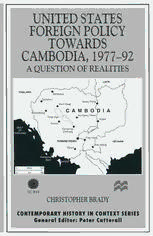
United States Foreign Policy towards Cambodia, 1977–92: A Question of Realities PDF
Preview United States Foreign Policy towards Cambodia, 1977–92: A Question of Realities
UNITED STATESFOREIGN POLICY TOWARDS CAMBODIA, 1977-92 CONTEMPORARYHISTORYINCONTEXT PublishedinassociationwiththeInstituteofContemporaryBritish History GeneralEditor:PeterCatterall,Director,InstituteofContemporaryBritish History Titlesinclude: OliverBange THE EECCRISIS OF 1963:Macmillan,deGaulle,AdenauerandKennedy in Conflict Christopher Brady UNITEDSTATESFOREIGNPOLICYTOWARDS CAMBODIA, 1977-92 PeterCatterall andSeanMcDougall(editors) THENORTHERNIRELANDQUESTIONINBRITISHPOLITICS Helen FawcettandRodney Lowe (editors) WELFAREPOLICYINBRITAIN:TheRoadfrom 1945 HarrietJones andMichael Kandiah(editors) THEMYTHOFCONSENSUS:New ViewsonBritish History,1945-64 Wolfram Kaiser USING EUROPE, ABUSINGTHEEUROPEANS:BritainandEuropean Integration, 1945-63 SpencerMawby CONTAININGGERMANY:BritainandtheArming oftheFederal Republic Jeffrey Pickering BRITAIN'S WITHDRAWALFROM EAST OFSUEZ:ThePolitics of Retrenchment L.V.Scott MACMILLAN,KENNEDYANDTHECUBANMISSILECRISIS:Political, MilitaryandIntelligenceAspects Paul Sharp THATCHER'S DIPLOMACY:TheRevival ofBritishForeignPolicy ContemporaryHistoryinContext SeriesStandingOrderISBN 978-0-333-71470-6 (outsideNortbAmericaonly) Youcanreceivefuturetitlesinthisseriesastheyarepublishedbyplacingastandingorder. Pleasecontactyourbookselleror,incaseofdifficulty, writetousattheaddressbelowwith yournameandaddress,thetitleoftheseriesandtheISBNquotedabove. CustomerServicesDepartment,Macmillan Distribution Ltd Houndmills,Basingstoke,HampshireRG2l 6XS,England United States Foreign Policy towards Cambodia, 1977-92 A Question of Realities Christopher Brady LecturerinDecision-MakingTheoryandSystems CityUniversityBusinessSchool London ~ in association with PALGRAVEMACMILLAN leBH FirstpublishedinGreatBritain 1999by MACMILLANPRESSLTD Houndmills,Basingstoke,HampshireRG216XSandLondon Companiesandrepresentativesthroughouttheworld AcataloguerecordforthisbookisavailablefromtheBritishLibrary. ISBN978-1-349-14847-9 ISBN978-1-349-14845-5(eBook) DOI 10.1007/978-1-349-14845-5 FirstpublishedintheUnitedStatesofAmerica1999by ST.MARTIN'SPRESS,INC., ScholarlyandReferenceDivision, 175FifthAvenue,NewYork,N.Y.10010 ISBN978-0-312-22021-1 LibraryofCongressCataloging-in-PublicationData Brady,Christopher,1947- UnitedStatesforeignpolicytowardsCambodia, 1977-92:a questionofrealities/ChristopherBrady. p. em.- (Contemporaryhistoryincontextseries) Includesbibliographicalreferencesandindex. ISBN978-0-312-22021-1 (cloth) I.UnitedStates-Foreignrelations-Cambodia. 2.Cambodia -Foreignrelations-UnitedStates. 3.UnitedStates-Foreign relations-1977-1981. 4.UnitedStates-Foreign relations-l98I-I989. 5.UnitedStates-Foreign relations-1989-1993. I.Title. II.Series. EI83.8.CI5B73 1999 327.730596--dc21 98-48284 CIP ©ChristopherBrady1999 Foreword©PeterCatterall 1999 Softeoverreprintofthe hardcover1stedition1999 Allrightsreserved.Noreproduction,copyortransmissionofthispublicationmaybemade withoutwrittenpermission. No paragraph of this publication may be reproduced, copied or transmitted save with written permission or inaccordance with the provisions of the Copyright, Designs and Patents Act 1988,or under theterms ofany licence permitting limitedcopyingissuedby theCopyrightLicensingAgency,90TottenhamCourtRoad,LondonW1P9HE. Anyperson whodoesanyunauthorisedactinrelationtothispublicationmaybeliableto criminalprosecutionandcivilclaimsfordamages. Theauthorhasasserted hisrighttobe identifiedastheauthorofthisworkinaccordance withtheCopyright,DesignsandPatentsAct1988. This book is printed on paper suitable for recycling and made from fully managed and sustainedforestsources. 109876543 2 I 08 07 06 05 04 03 02 OJ 00 99 For Tara, Ellie and Patrick Contents GeneralEditor'sForeword IX Acknowledgement XI List ofAbbreviations xii Chronology xiv Prologue 1 Introduction 8 1 The CarterAdministration 13 The Administration 14 Level One 15 Level Two 17 Level Three 19 Conflict 20 Foreign Policy 23 The Administration's Reality 25 Alternative Realities 32 Amalgam of Realities 37 Conclusion 46 2 The First Reagan Administration 50 TheAdministration 51 Level One 56 Level Two 58 Level Three 60 Conflict 61 Foreign Policy 61 TheAdministration's Reality 65 Alternative Realities 76 Amalgam ofRealities 89 Conclusion 92 3 The Second Reagan Administration 95 The Administration 96 Level One 97 Level Two 99 Level Three 103 VII Vlll Contents Conflict 104 Foreign Policy 105 TheAdministration's Reality 110 Alternative Realities 115 Amalgam of Realities 128 Conclusion 133 4 The Bush Administration 135 TheAdministration 137 Level One 139 Level Two 142 Level Three 143 ~~~ 1M Foreign Policy 145 TheAdministration's Reality 149 Alternative Realities 160 Amalgam of Realities 172 Conclusion 178 Conclusion 181 Epilogue 189 Notes 195 Select Bibliography 219 Index 225 General Editor's Foreword Palmerstonfamously argued thatstatesdo nothave permanentallies, only permanent interests. But how are these permanent interests calculated and pursued? The answer offered in Chris Brady's case studyofUSpolicytowardsCambodia 1977-92isthatthe primefactor is the explicit or implicit understandings on which policy-makers proceed. In other words, policy is based on how those who make it construct reality. Policy-making is thus directed at managing or changing (depending on priorities) that constructed reality. That realityisnot necessarilysingular.As Brady shows, policy-makingmay be the end-product of a bureaucratic process in which a number of different realities, both of the situation in Cambodia and how it relates to US interests, compete. This could result in apparently contradictory outcomes. For instance, the over-arching rhetoric of the Carter administration, the absolutecommitmentto human rights invokedinhisfirst inauguralin 1977, seems dramatically at odds with subsequent policy towards Cambodia under Pol Pot. The Khmer Rouge may have been inter national pariahs as far as Congressional critics were concerned. But successive administrationsconstructedtheirpolicytowardsCambodia within a rather different context. The prism through which they viewed Cambodia was not distinctive to Cambodia itself. Nor was it the human rights agendawhich the Carteradministration had overtly set itselfwhich determined howitwasviewed. Rather, policy towards Cambodiawasconstructed inasettinginwhich the Cold Warwasthe dominant reality. The pursuit of human rights, as Brady shows in his account of the conflict between Vance and Brzezinski under Carter, was to prove subordinate to this over-arching theme. Cambodia, therefore,despitethe significanceitmight have beenexpectedtohave had, was no more than a minoractorinthe Cold War. Policytowards Cambodia was thus determined by an environment in which opposi tion to Vietnam, particularly as a Soviet ally, was more significant than abhorrence of the Khmer Rouge.Admittedly US policy-makers would probably have preferred a more palatable choice than one between Vietnam and the Khmer Rouge, but much of the time there were, inpractice,only the most limitedalternatives. One of the main reasons why US alternatives were so limited was IX x GeneralEditor's Foreword because of a subordinate, but nevertheless influential reality which impinged significantly on its options. This wasthe apparent lesson of the Vietnam War. As Brady shows, there was considerable debate about what these lessons were for policy-makers in the period under review. George Bush, in the end, was to revise these lessons. However, this did not seem to undermine the significance of the key lesson asfar aspolicytowards Cambodiawasconcerned.Thiswasthe need to avoid any further entanglements such as the Vietnam War. Therefore, whilst human rights might be on the agenda, there were strict limits to howthese might be pursued, particularly in asituation where none ofthe possible alternatives,whetherSihanouk,the KR or the Vietnamese to take some examples, seemed both feasible and desirable.The result wasthatUS policytowards Cambodiatended to be reactive. Instead, the US sought to align its policy with that of ASEAN, asthe relevantregionalactor. Insofarasithad aCambodian policy,asdistinct from the wayinwhichthe Cold War impinged upon its policytowards Cambodia, it reflected this constructed reality that the best way to pursue it was in association with and through the agency ofASEAN. This remained true with the end of the Cold War. In a sense the unravelling of the Soviet Union created opportunities for a shift in policytowards Cambodia,byremoving the prime determinantofthat policy hitherto. Indeed, policywas to shift during the Bush adminis tration, because one of the major elements in the construction of the policy-makers' reality had gone. However, the lessons of Vietnam were nevertheless still there. Chris Brady thus shows us that the construction of reality not only drives foreign policy-making, it also constrains it. PETER CATfERALL
